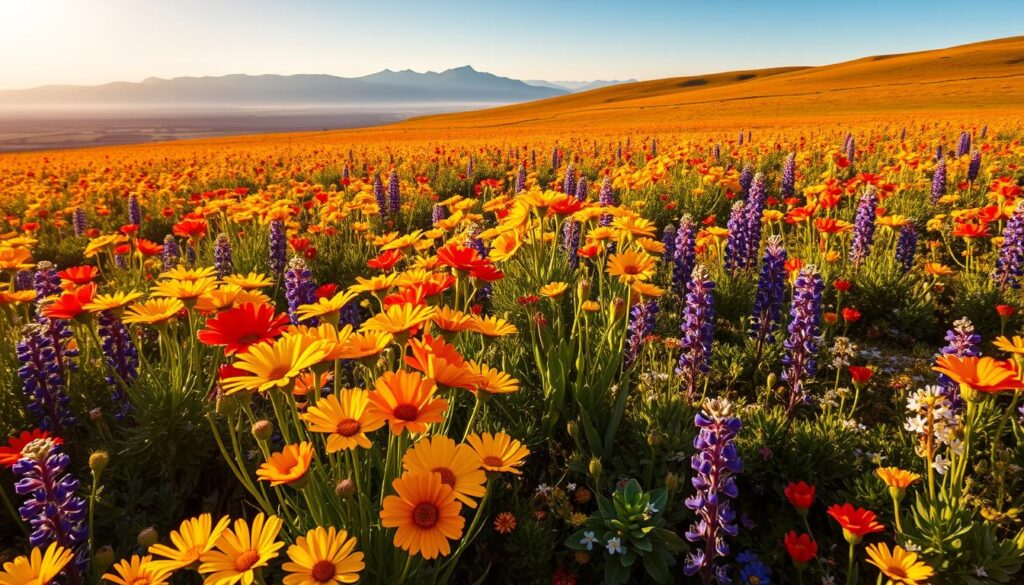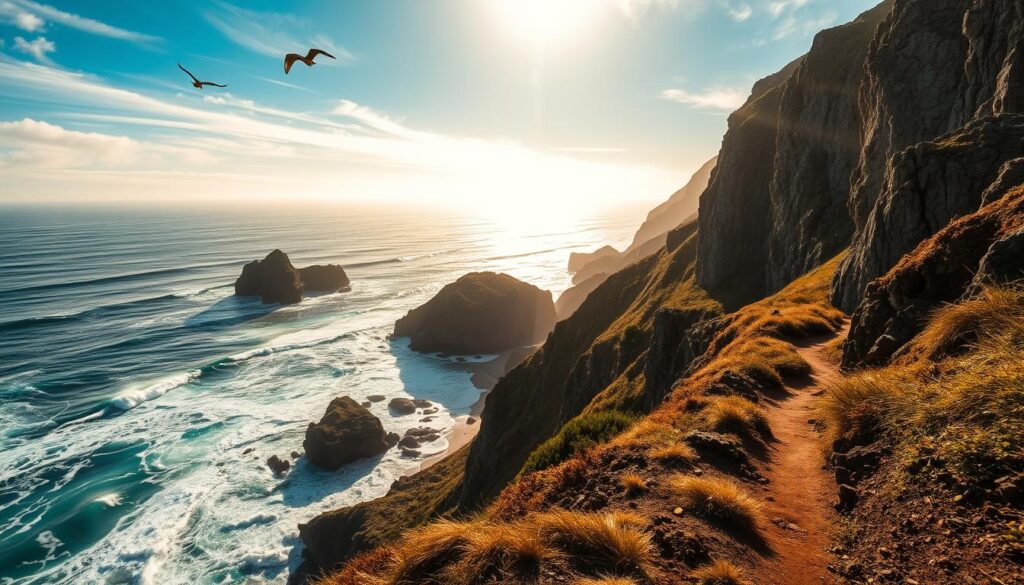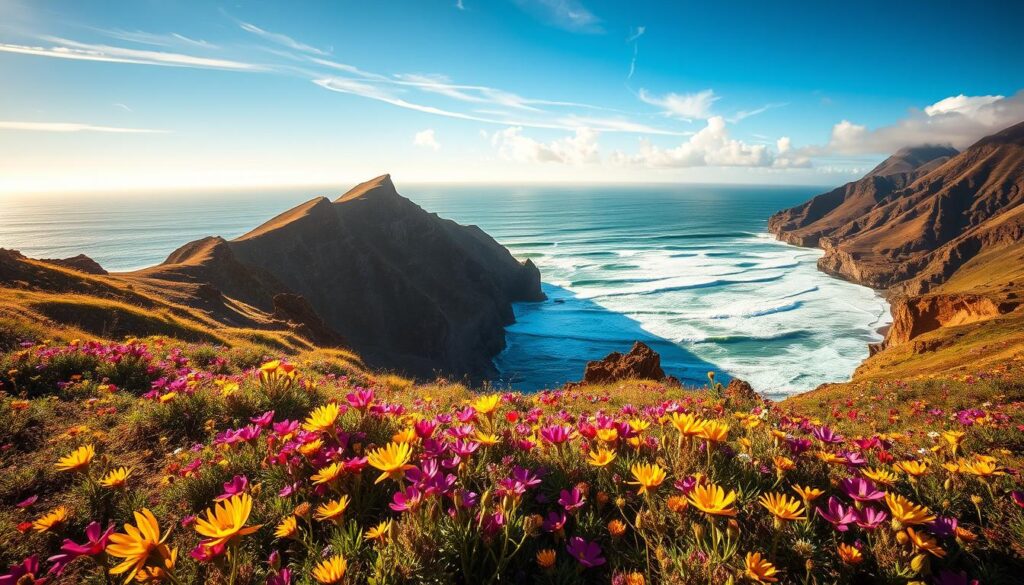Surprising fact: over 4,000 plant species thrive here, with roughly 1,000 found nowhere else on earth — a botanical concentration that rivals national parks many times larger.
Your quick answer: this south africa region turns from stark semi-desert into riotous spring carpets of wildflowers, framed by a raw Atlantic coastline sprinkled with shipwrecks and wide, lonely tracks that invite exploration.
The area lies about six hours from cape town along the west coast, split by the Orange River into Little and Great sections. Towns like Kamieskroon and Springbok act as bases for drives, hikes, and 4×4 routes.
Why visit now: if you want uncrowded nature, dramatic light, and a cultural thread tied to the Nama people, this region delivers. Expect granite kopjes, protected parks, birdlife like Verreaux’s eagle, and long stretches of remote coastline.
Plan your hours on the road, fuel early, carry water, and we’ll guide your route, season timing, safety tips, and the best places to camp and hike.
Key Takeaways
- Namaqualand offers a unique spring bloom and rugged Atlantic coastline that reward independent travelers.
- The region sits about six hours from Cape Town along the west coast, split by the Orange River.
- Over 4,000 plant species and rich birdlife make this an important nature and conservation area.
- Expect remote 4×4 tracks, hiking, mountain biking, and protected places like Namaqua National Park.
- Plan fuel, water, and hours on the road; safety and timing are key to a smooth trip.
Quick Answer and Why It Matters Right Now
The bloom arrives in a pulse—driven by winter rains—and it changes the landscape almost overnight. This short spring window creates spectacular carpets of flowers that draw travelers seeking uncluttered nature and vivid photography.
Timing is everything: peak color usually runs from late August to late September, though blooms can begin as early as late july early after good rains. Sunny days matter—many flower heads stay closed on overcast or rainy days.
Table of Clarity
| Need | Quick guide | Best practice |
|---|---|---|
| Peak color | Late August–late September | Watch daily updates and local comments |
| Morning viewing | Mid-morning to mid-afternoon | Choose sunny, wind-sheltered north-facing spots |
| Early sightings | Late july early depending on rains | Start near Postberg, Hantam, Skilpad |
Geographic and cultural context
The core viewing lies across the West Coast and northern cape, roughly six hours by road from cape town. The Orange river cuts the area, forming a natural border and splitting the landscape into namaqualand south and the northern part beyond the river.
“Nama-kwa” means the land of the Nama people. Afrikaans is widely spoken, and local guides and tourism offices post timely comments and spot updates that help you chase the best displays.
What is Namaqualand famous for?

When winter rains come, compact succulents and bulbs wake and carpet hills, pans, and coastal flats. The famous flower season runs from late July through early October, though peak color often appears between late August and September.
The Famous Flower Season: timing and highlights
Sunshine matters: many wildflowers open only on clear days, so chase sunny windows. Expect bright Namaqua daisy and vygies, bulbs at Hantam botanical garden, and succulents like Botterboom and halfmens in Richtersveld.
Where to see the best displays
Top places: Skilpad inside namaqua national park offers sweeping compositions; Goegap nature reserve blends scenery and wildlife; Postberg (West Coast) opens during the flower season; Hantam botanical garden in Nieuwoudtville shows bulbs and rock gardens.
Wildlife, rivers and culture
Look for the speckled padloper, klipspringer, and raptors such as Verreaux’s eagle. The Orange river threads life through arid plains while the Atlantic coast adds shipwrecks and marine sightings.
“Ask park rangers about today’s best spots—local comments often point to fresher fields and quieter tracks.”
- High plant diversity: thousands of plant species with many endemics.
- Parks and protection: national park sites and nature reserve networks guard key habitats.
- Living heritage: “Nama‑kwa” names and Khoekhoe language link land and people.
Best Time to Visit and How to Plan Your Trip

Plan your visit around clear skies—sunny mornings and calm afternoons bring the landscape to life. The best time spans late August to late September in a good season. Expect some color from late july early or july early when winter rains have been generous.
Season timing: blooms open roughly between 10 a.m. and 4 p.m. on sunny days. If it’s overcast or rainy, save field walks and use the day for scenic drives and coastal detours.
From cape town, take the N7 north and link Darling, West Coast National Park, Clanwilliam, Vanrhynsdorp and Nieuwoudtville before heading into Garies, Springbok and Kamieskroon. Stitch your routes to cut backtracking.
Trip length, bases and safety
Give yourself at least 5–7 days. Use two to three bases: Nieuwoudtville for bulbs, Kamieskroon for park loops and Springbok for wider access. Consider flower camps in Namaqua National Park or self-drive loops to stay flexible.
| Need | Advice | Why it matters |
|---|---|---|
| When to come | Late Aug–late Sep | Peak color window |
| Early starts | Late july options | Rains bring early blooms |
| Daily rhythm | 10:00–16:00 | Flowers open in sun |
| Safety | Fuel, water, paper map | Remote roads and gravel |
“Check local comments each morning—community updates often point to fresher spots.”
- Keep extra water and snacks.
- Drive with the sun behind you to photograph blooms.
- Add an Orange River paddle for a cool break and birdwatching.
Beyond the Blooms: Adventures, Wildlife, and Coastal Drama

Adventure here threads river canoes, wind-swept beaches, and rugged desert passes into a compact playground. Pack a paddle and a sense of curiosity—your trip can change every day.
Orange River Excursions
Paddle the lifeline—the river offers half-day to multi-day canoe and rafting options. Guides point out kingfishers and herons along quiet reedbeds. Swim, camp, and watch bird species gather at dusk.
Windswept Atlantic Beaches
The coast is raw and dramatic. 4×4 routes reach shipwrecks, tide pools, and dunes where dolphins and seasonal whales may appear. Coastal sections inside namaqua national create moody light for photographers.
Goegap, Richtersveld and Nightlife
Goegap nature reserve near Springbok lists 92 bird species and over 45 mammals such as Hartmann’s zebra and aardwolf.
Richtersveld (a UNESCO world site) protects halfmens succulents and mountain desert silence. Seasonal flower camps put you under prime stargazing skies.
| Attraction | Top activity | Highlights |
|---|---|---|
| Orange River | Canoe/raft | Birding, swimming, overnight camps |
| Atlantic coast | 4×4 beach runs | Shipwrecks, dolphins, flamingos |
| Goegap Nature | Hiking | 92 bird species, 45+ mammals |
| Richtersveld | 4×4 passes | Halfmens succulents, UNESCO landscapes |
“Choose one day by the sea and the next in the koppies—this area rewards slow travel and surprise.”
- Practical: follow signed routes and carry water.
- Evening: enjoy a south african braai and starry skies at flower camps.
- Tip: keep the sun behind you on morning drives to capture color and species in flight.
Conclusion
Plan your days around sunny hours—those are when the blooms truly open. In this northern cape region, late-winter rain sparks the dramatic flower season that turns arid tracks into seas of color.
Quick takeaway: the best time is spring, typically late August through September, with early signs from late july when rains cooperate. Aim first at namaqua national park, Hantam botanical garden, Goegap nature reserve and Postberg on the west coast.
Safety matters: fuel often, carry extra water, slow down on gravel, and tell someone your route. Watch the Orange River corridors and local comments for fresher spots.
Picture your last afternoon: succulents and daisies under wide south africa skies, a braai at camp, and the lasting sense that this area changed your way of seeing time and place on your trip.
FAQ
What makes this region so famous?
A dramatic spring bloom transforms arid plains into carpets of wildflowers. The floral display, centered in the Succulent Karoo, draws nature lovers and photographers from around the world to witness vivid daisies, vygies, succulents and rare bulbs against a stark desert-coast backdrop.
Quick answer — when should your trip be planned and why does timing matter now?
Plan for late July through early October for peak displays. Seasonal rains, cooler winters and clear sunny days determine bloom timing, so visiting those weeks gives the best chance for sweeping colour and comfortable field conditions.
Where exactly are the best viewing spots and how do they differ?
Key locations include Namaqua National Park (Skilpad rest camps and wildflower routes), Goegap Nature Reserve near Springbok, Hantam Botanical Garden around Nieuwoudtville, and Postberg in West Coast National Park. Each site offers distinct terrain — coastal flats, rocky outcrops, and mountain valleys — which affect the variety and density of blooms.
Which iconic plants should you look out for on your visit?
Watch for Namaqua daisies, vygies (mesembs), various bulbs like watsonias, and myriad succulents including the tiny speckled padloper. Many species are endemic to the Cape Floristic and Succulent Karoo regions, making sightings special and often rare.
How does rainfall influence the flower season?
Rainfall is the main trigger for germination and flowering. A wetter winter and early spring typically produce a better display. Conversely, drought years or uneven rain patterns can delay or reduce blooms, so flexibility and local reports matter when planning.
Can you combine floral viewing with wildlife and coastal activities?
Absolutely. The area pairs flower walks with birdwatching, antelope and small mammal sightings, Orange River excursions, and dramatic Atlantic coastline exploration — including shipwreck sites and marine wildlife viewing from the shore.
What practical routes and bases work best when coming from Cape Town?
Drive north along the N7 to Springbok and turn-offs for Goegap or Namaqua National Park routes. Day trips work from towns like Springbok and Springbok’s surrounding farms; longer itineraries include Sutherland or Upington when exploring Richtersveld or the Orange River.
How many days should you allow to enjoy flower country properly?
A focused 2–4 day visit covers a main reserve and nearby drives. For a richer itinerary — several parks, river activities and coastal stops — allow 6–10 days. Stay flexible to chase peak blooms as conditions shift.
Are there organised flower camps or should you self-drive?
Both options exist. Flower camps and guided tours provide local insight and access to prime patches; self-drives give freedom to explore remote lanes and adjust timing. Choose based on your comfort with gravel roads and navigation in rural areas.
What safety and health tips should you follow in remote areas?
Carry plenty of water, sun protection and a first-aid kit. Expect long stretches without services — keep spare fuel, a charged phone and offline maps. Drive carefully on gravel roads and respect private farmland and park rules.
How accessible are reserves like Namaqua National Park and Goegap for families?
Both offer family-friendly trails, picnic sites and short walks suitable for kids. Some routes are rugged; choose lower-difficulty trails and plan shade and rest breaks during sunny days.
What cultural or historical experiences complement a flower-focused trip?
Explore Nama and Khoekhoe cultural history in local museums and community-run sites, visit small-town markets, and sample Northern Cape cuisine. The region’s place names, rock art and oral histories enrich the natural spectacle with human stories.
Which parks are UNESCO-recognized or otherwise globally significant?
The Succulent Karoo biome is globally important for plant diversity and endemism; parts of the Richtersveld are a UNESCO World Heritage Site for cultural and botanical values. These designations underscore conservation priorities when you visit.
Can you combine a flower trip with a stargazing or 4×4 adventure?
Yes — clear, low-light skies make the Northern Cape superb for stargazing. Rugged routes and mountain desert areas offer excellent 4×4 trails. Always notify someone of remote plans and follow permitted routes in protected areas.
How should you minimize impact while enjoying the blooms?
Stay on marked trails, avoid picking flowers or disturbing plants, respect private land, and follow park regulations. Leave no trace and support local conservation initiatives and community tourism to help protect this fragile wildflower landscape.
- Kaas Plateau Travel Guide 2026: Best Time to Visit, Bloom Season, How to Reach & FAQs
- What Is the Quirimbas Archipelago Mozambique Known For? Complete Travel & Nature Guide
- Is Angola Safe to Travel in 2025? Your Essential Guide to Health, Crime, and Landmine Safety
- What Animals Live in Bale Mountains Ethiopia? Complete Wildlife Guide
- What to Do in Damaraland — Complete Travel Guide for First-Timers

